brake light LEXUS LS430 2006 Owners Manual
[x] Cancel search | Manufacturer: LEXUS, Model Year: 2006, Model line: LS430, Model: LEXUS LS430 2006Pages: 419, PDF Size: 11.19 MB
Page 2 of 419
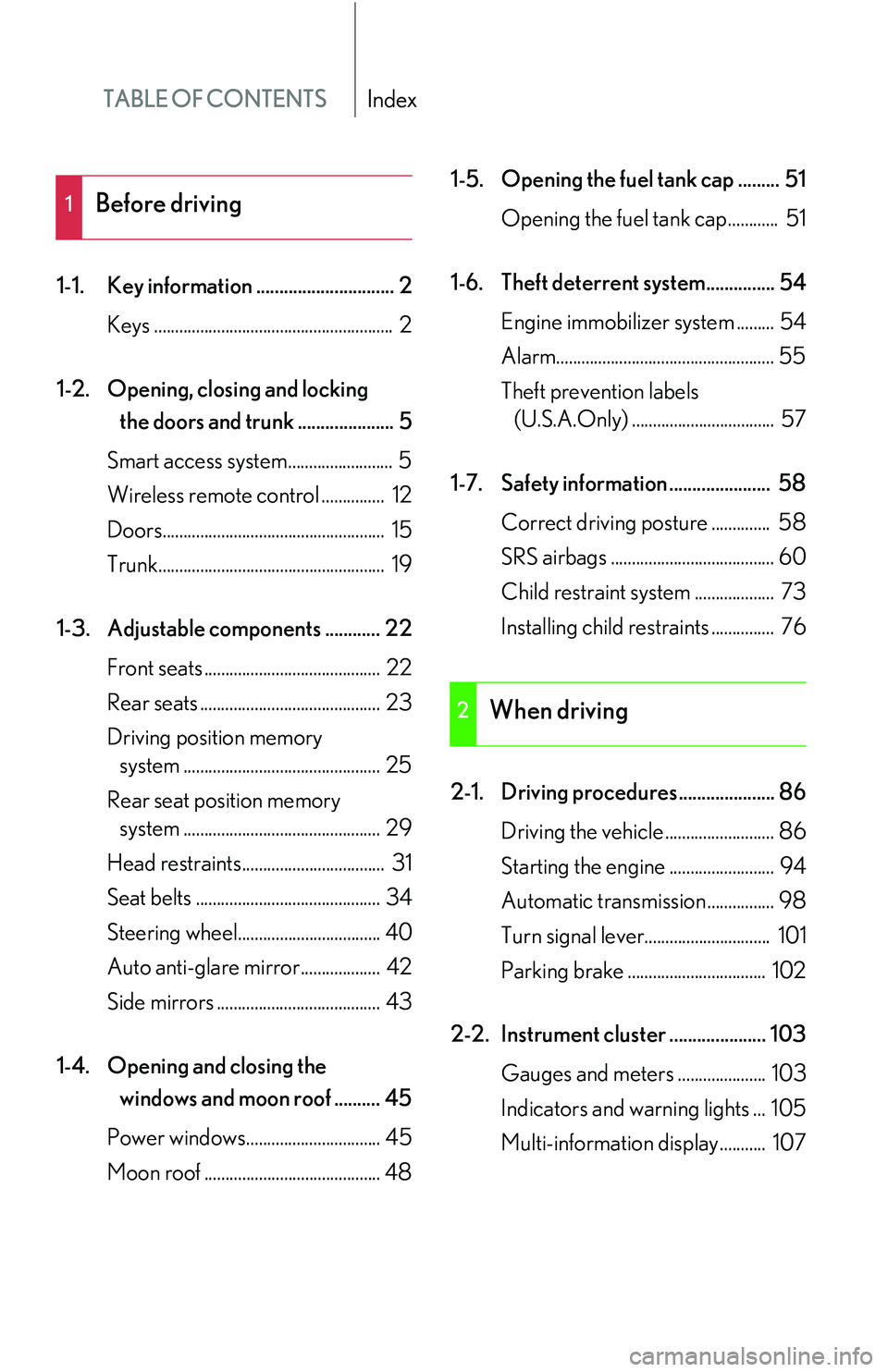
TABLE OF CONTENTSIndex
1-1. Key information .............................. 2Keys ......................................................... 2
1-2. Opening, closing and locking
the doors and trunk ..................... 5
Smart access system......................... 5
Wireless remote control ............... 12
Doors..................................................... 15
Trunk...................................................... 19
1-3. Adjustable components ............ 22 Front seats .......................................... 22
Rear seats ........................................... 23
Driving position memory
system ............................................... 25
Rear seat position memory
system ............................................... 29
Head restraints.................................. 31
Seat belts ............................................ 34
Steering wheel.................................. 40
Auto anti-glare mirror................... 42
Side mirrors ....................................... 43
1-4. Opening and closing the
windows and moon roof .......... 45
Power windows................................ 45
Moon roof .......................................... 48 1-5. Opening the fuel tank cap ......... 51
Opening the fuel tank cap............ 51
1-6. Theft deterrent system............... 54 Engine immobilizer system ......... 54
Alarm.................................................... 55
Theft prevention labels
(U.S.A.Only) .................................. 57
1-7. Safety information ...................... 58 Correct driving posture .............. 58
SRS airbags ....................................... 60
Child restraint system
................... 73
Installing child restraints ............... 76
2-1. Driving procedures..................... 86 Driving the vehicle .......................... 86
Starting the engine ......................... 94
Automatic transmission................ 98
Turn signal lever.............................. 101
Parking brake ................................. 102
2-2. Instrument cluster ..................... 103 Gauges and meters ..................... 103
Indicators and warning lights ... 105
Multi-information display........... 107
1Before driving
2When driving
Page 11 of 419
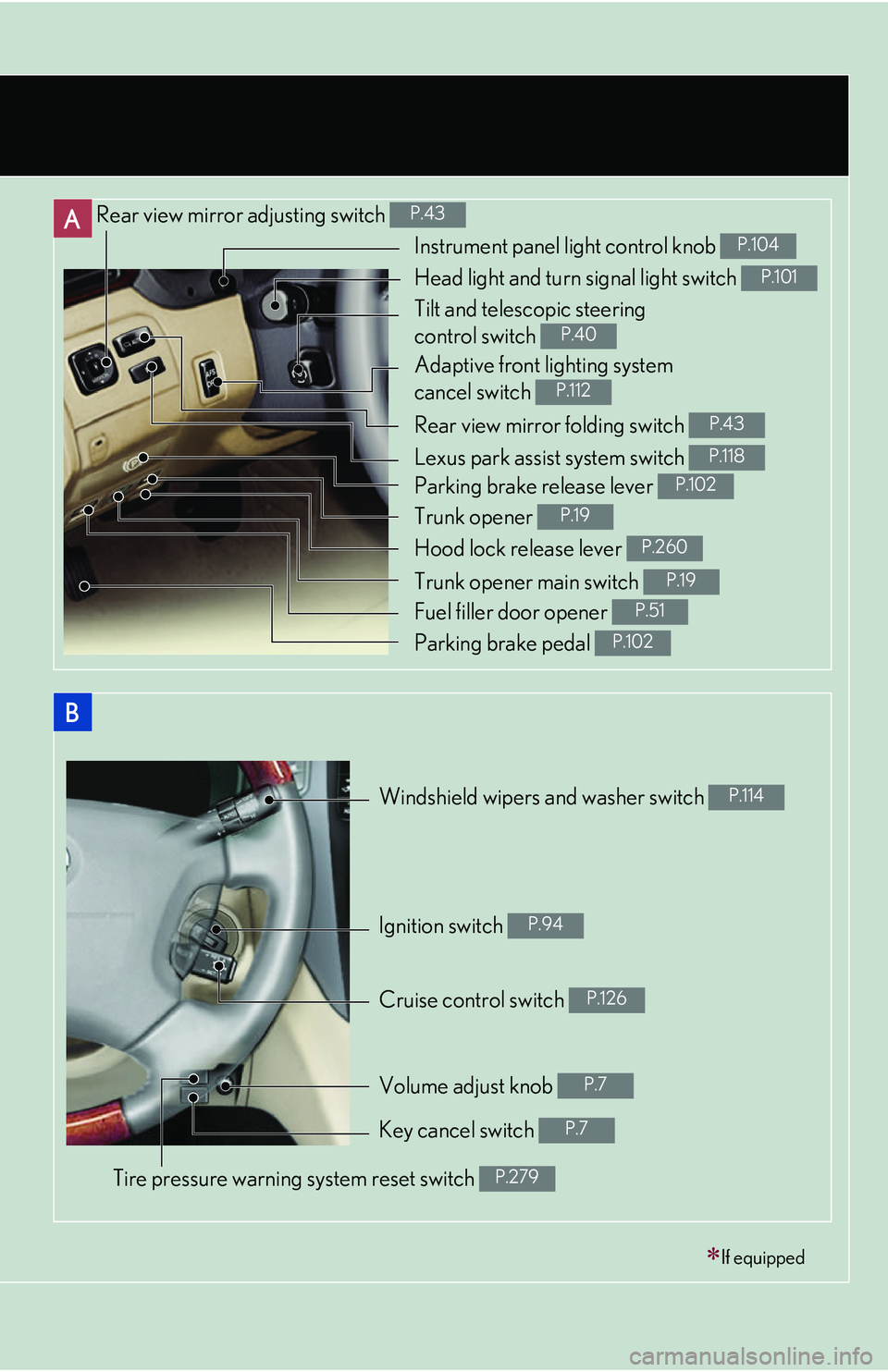
A
B
Rear view mirror adjusting switch P.43
Rear view mirror folding switch P.43
Windshield wipers and washer switch P.114
Cruise control switch P.126
If equipped
Instrument panel light control knob P.104
Head light and turn signal light switch P.101
Tilt and telescopic steering
control switch
P.40
Adaptive front lighting system
cancel switch
P.112
Lexus park assist system switch P.118
Parking brake release lever P.102
Trunk opener P.19
Hood lock release lever P.260
Trunk opener main switch P.19
Fuel filler door opener P.51
Parking brake pedal P.102
Ignition switch P.94
Volume adjust knob P.7
Key cancel switch P.7
Tire pressure warning system reset switch P.279
Page 101 of 419
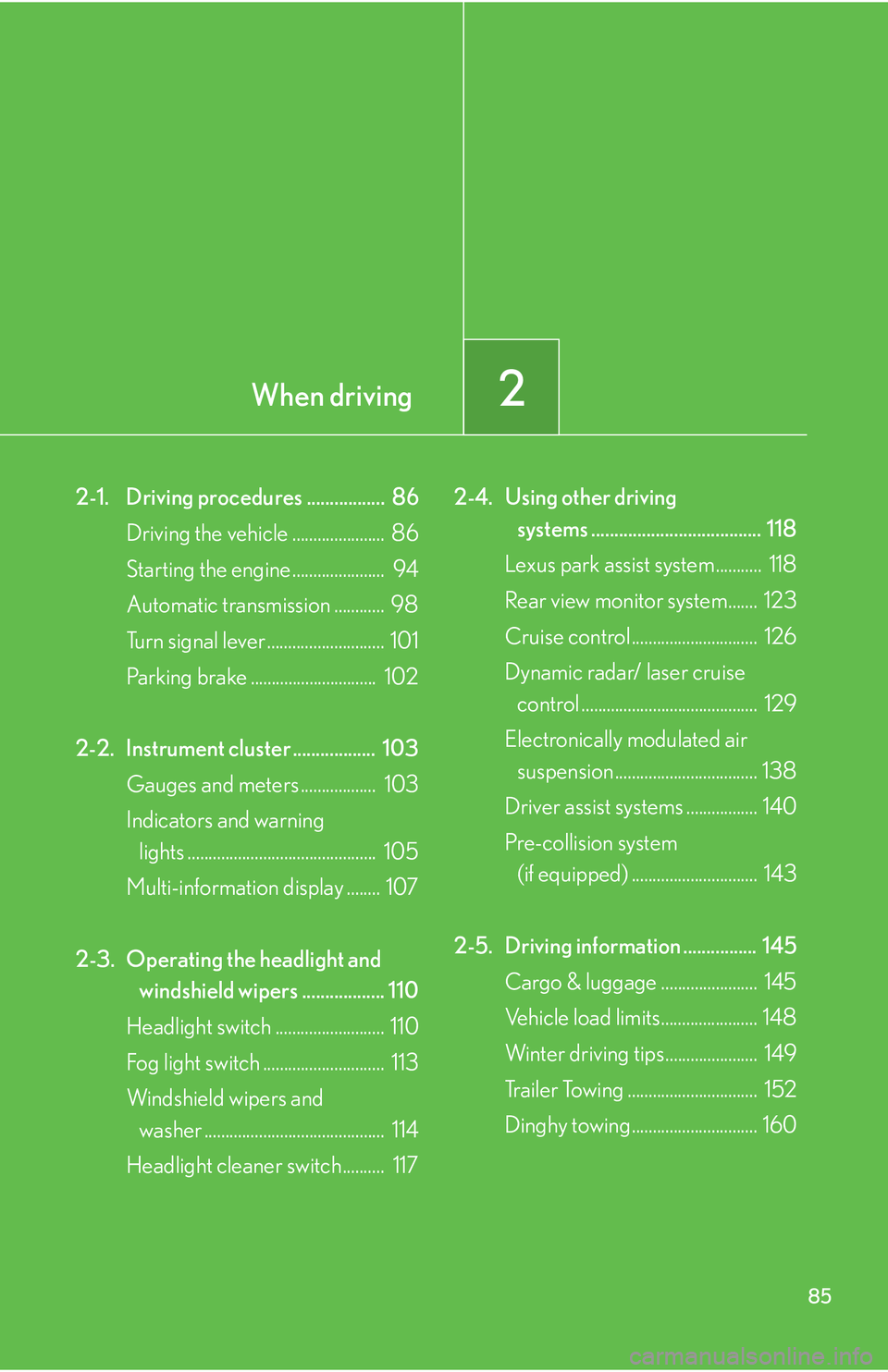
2When driving
85
2-1. Driving procedures ................. 86Driving the vehicle ...................... 86
Starting the engine ...................... 94
Automatic transmission ............ 98
Turn signal lever ............................ 101
Parking brake .............................. 102
2-2. Instrument cluster .................. 103 Gauges and meters .................. 103
Indicators and warning
lights ............................................. 105
Multi-information display ........ 107
2-3. Operating the headlight and
windshield wipers .................. 110
Headlight switch .......................... 110
Fog light switch ............................. 113
Windshield wipers and
washer ........................................... 114
Headlight cleaner switch.......... 117 2-4. Using other driving
systems ..................................... 118
Lexus park assist system ........... 118
Rear view monitor system....... 123
Cruise control .............................. 126
Dynamic radar/ laser cruise
control .......................................... 129
Electronically modulated air
suspension.................................. 138
Driver assist systems ................. 140
Pre-collision system
(if equipped) .............................. 143
2-5. Driving information ................ 145 Cargo & luggage ....................... 145
Vehicle load limits....................... 148
Winter driving tips...................... 149
Trailer Towing ............................... 152
Dinghy towing.............................. 160
Page 107 of 419

91
2-1. Driving procedures
2
When driving
CAUTION
■When the vehicle is parked
●Do not leave glasses, cigarette lighters, spray cans, or soft drink cans in the vehi-
cle in hot areas.
• Gas may leak from a cigarette lighter or spr
ay can, and may lead to a fire.
• The temperature inside the vehicle may cause the plastic lenses and plastic
m
aterial of glasses to deform or crack.
• Soft drink cans may fracture, causing the co ntents
to spray over the interior of
the vehicle, and may also cause a short circuit in the vehicle’s electrical com -
ponents.
●Always set the parking brake, shift the se lector lever to P, stop the engine and
lock the vehicle.
Do not leave the vehicle unattend ed
while the engine is running.
●Do not leave the engine running in an area with snow build up, or where snow is
expected to fall.
Exhaust gases may enter the interior of the vehicle and cause gas poisoning.
■When taking a nap in the vehicle
Always turn the engine off. Otherwise, you may accidentally move the selector
le
ver or press the accelerator pedal, which could cause an accident or fire due to
abnormal engine overheating. Additionally, if the vehicle is parked in a poorly venti-
lated area, exhaust fumes may enter the vehicle and cause gas poisoning.
Page 127 of 419

111
2-3. Operating the headlight and windshield wipers
2
When driving
Daytime running light system
The headlights turn on automatically (at a reduced intensity) whenever the
engine is started and the parking brake is released to make your vehicle
more visible to other drivers. Dayt ime running lights are not designed for
use at night.
■Headlight control sensor
■Automatic light off system
The headlights turn off automatically if the engine is stopped and the driver’s door is
opened wh
ile the headlights are turned on.
To turn the headlights on again, turn the key to ON, or turn the light switch off once
and then
back to or position.
■Automatic headlight leveling system
The level of the headlights is
automatically adjusted according to the number of
passengers and the loading condition of the vehicle to ensure that the headlights do
not interfere other road users.
■Customization
The time it takes for the headlights to automatically turn on or off can be changed.
( P.384 )
The sensor may not function properly if an
object is placed on the sensor, or anything
that blocks the sensor is affixed to the wind-
shield.
Doing so interferes with the sensor detect-
ing the level of ambient light and may cause
the automatic headlight system malfunc-
tion.
Page 148 of 419
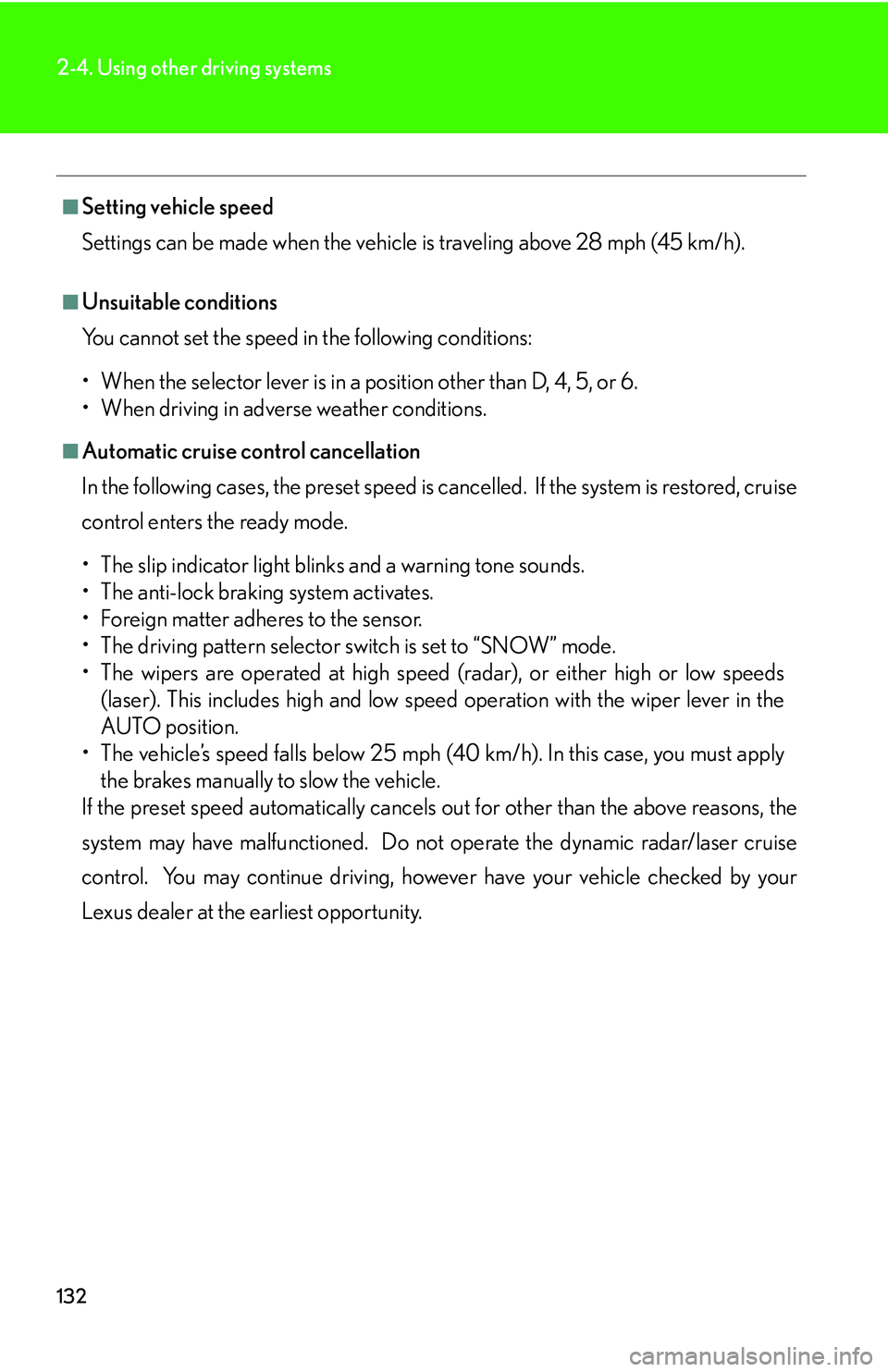
132
2-4. Using other driving systems
■Setting vehicle speed
Settings can be made when the vehicle
is traveling above 28 mph (45 km/h).
■Unsuitable conditions
You cannot set the speed in the following conditions:
• When the selector lever is in a position other than D, 4, 5, or 6.
• When driving in adverse weather conditions.
■Automatic cruise control cancellation
In the following cases, the preset speed is can ce
lled. If the system is restored, cruise
control enters the ready mode.
• The slip indicator light blinks and a warning tone sounds.
• The anti-lock braking system activates.
• Foreign matter adheres to the sensor.
• The driving pattern selector sw it
ch is set to “SNOW” mode.
• The wipers are operated at high speed (radar), or either high or low speeds (l
aser). This includes high and low speed operation with the wiper lever in the
AUTO position.
• The vehicle’s speed falls below 25 mph (40 km/h). In this case, you must apply th
e brakes manually to slow the vehicle.
If the preset speed automatically cancels out for other than the above reasons, the
sy
stem may have malfunctioned. Do not operate the dynamic radar/laser cruise
control. You may continue driving, howe ver have your vehicle checked by your
Lexus dealer at the earliest opportunity.
Page 157 of 419

141
2-4. Using other driving systems
2
When driving
To disable VSC and TRAC
If the vehicle gets stuck in fresh snow or mud, VSC and TRAC may
reduce power from the engine to the wheels. You may need to turn VSC
and TRAC off to enable you to rock the vehicle in order to free the vehi-
cle.
Push the button to turn off VSC
and TRAC.
The TRAC OFF indicator light
turns on.
Push the button again to turn the
sy
stem back on.
1
■Operating sounds and vibrations caus ed by the ABS, VSC & TRAC systems
●A sound may be heard from the engine compartment when the engine is
started or just after the vehicle begins to move. This sound does not indicate that
a malfunction has occurred in any of these systems.
●Any of the following conditions may occur when the ABS, VSC and TRAC sys -
tems are operating. None of these indicates that a malfunction has occurred.
• A sound may be heard.
• Vibrations may be felt through the vehicle body and steering.
• A motor sound may be heard after the vehicle comes to a stop.
• The brake pedal may pulsate slightly while the ABS is activated.
• The brake pedal may move forward slightly after the ABS is activated.
■Failure warning for VSC or TRAC system
If an error in the VSC or TRAC systems is
detected, the master warning light and
TRAC OFF indicator light comes on, a warning tone sounds. (P.334 )
Page 160 of 419
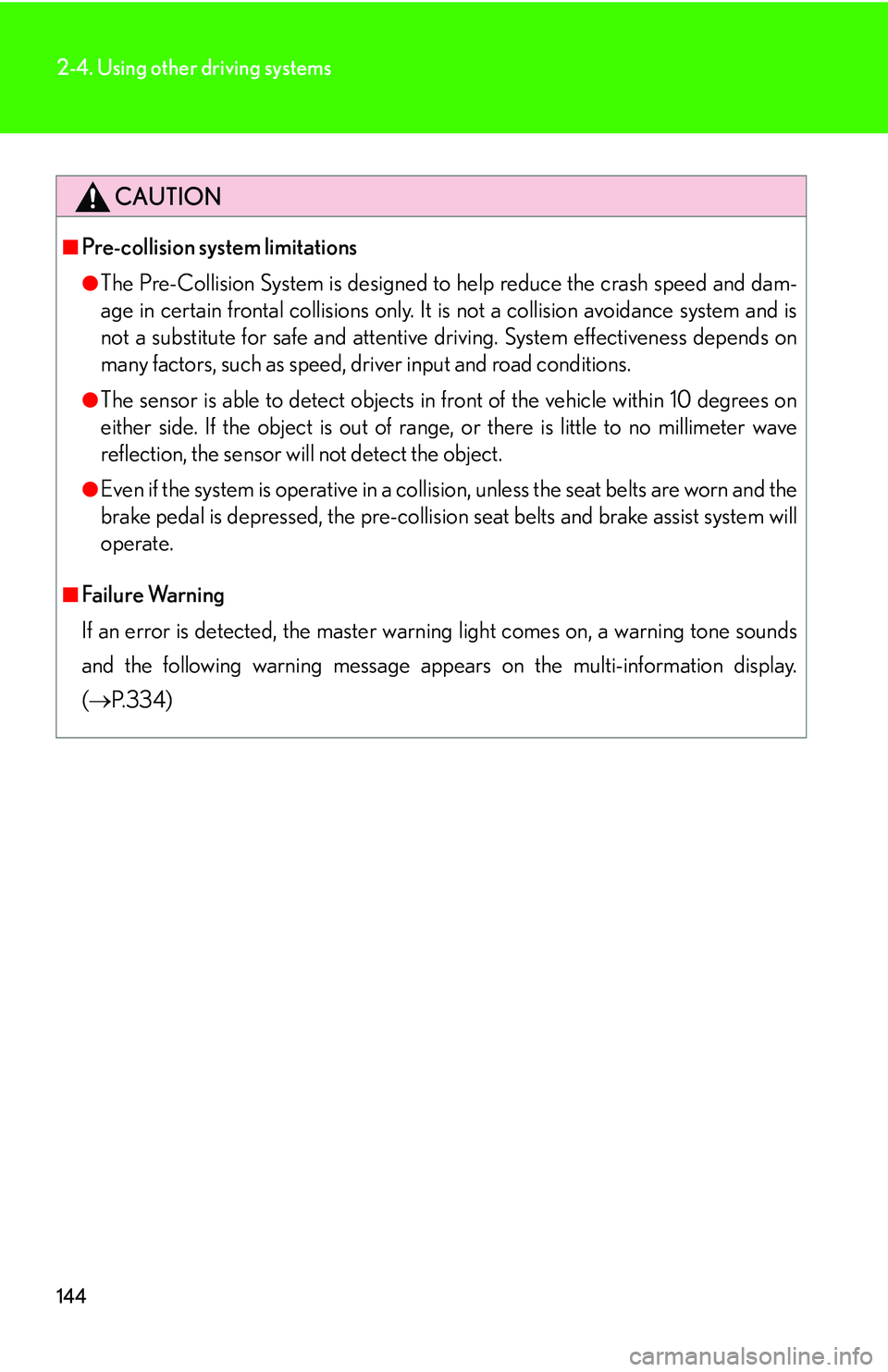
144
2-4. Using other driving systems
CAUTION
■Pre-collision system limitations
●The Pre-Collision System is designed to help reduce the crash speed and dam-
age in certain frontal collisions only. It is not a collision avoidance system and is
no
t a substitute for safe and attentive driving. System effectiveness depends on
many factors, such as speed, dr iver input and road conditions.
●The sensor is able to detect objects in front of the vehicle within 10 degrees on
either side. If the object is out of range, or there is little to no millimeter wave
reflection, the sensor will not detect the object.
●Even if the system is operative in a collisio n, unless the seat belts are worn and the
brake pedal is depressed, the pre-collision seat belts and brake assist system will
operate.
■Failure Warning
If an error is detected, the master warn i
ng light comes on, a warning tone sounds
and the following warning message appears on the multi-information display.
( P.334 )
Page 171 of 419
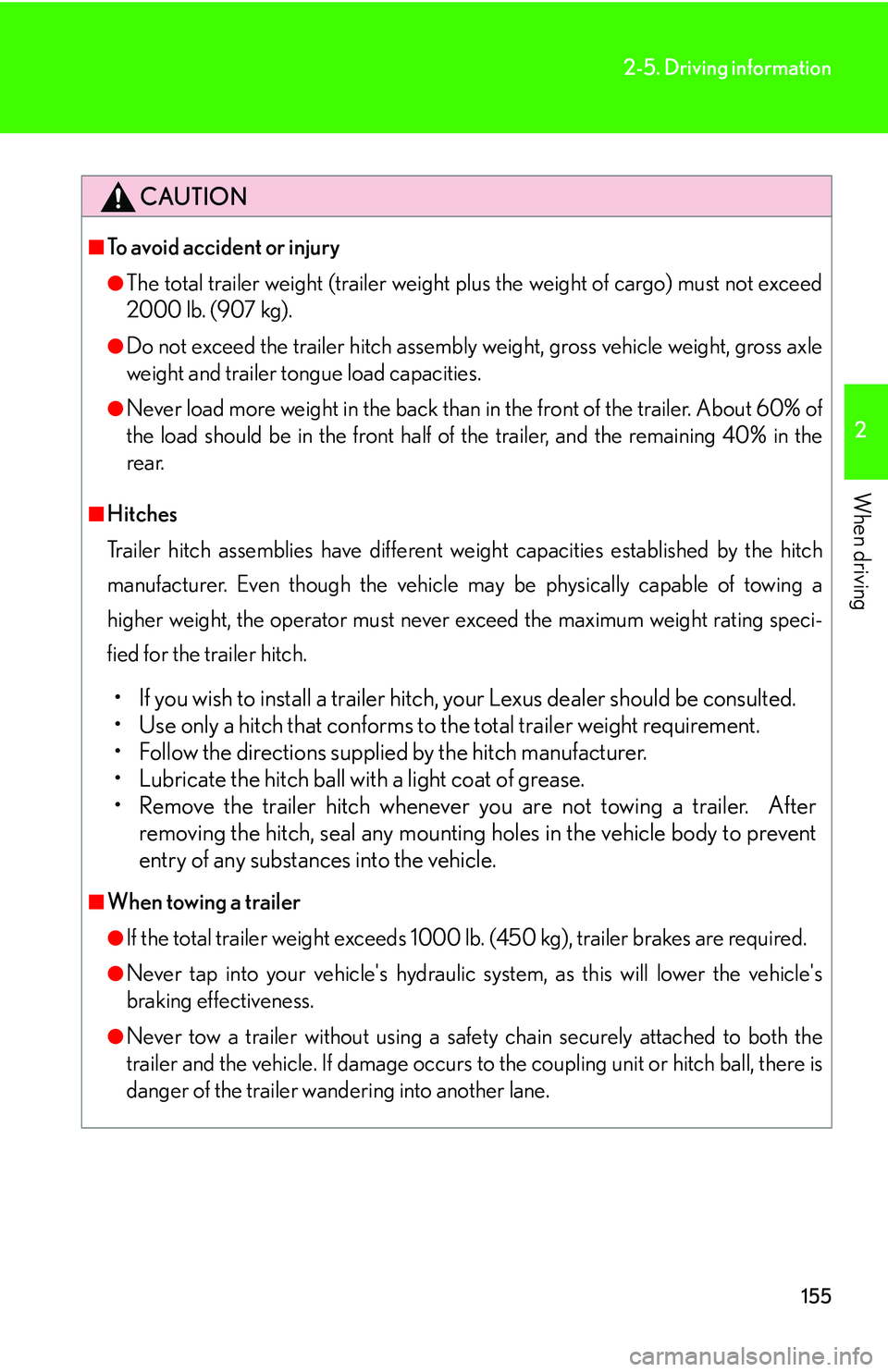
155
2-5. Driving information
2
When driving
CAUTION
■To avoid accident or injury
●The total trailer weight (trailer weight plus the weight of cargo) must not exceed
2000 lb. (907 kg).
●Do not exceed the trailer hitch assembly weight, gross vehicle weight, gross axle
weight and trailer tongue load capacities.
●Never load more weight in the back than in the front of the trailer. About 60% of
the load should be in the front half of the trailer, and the remaining 40% in the
rear.
■Hitches
Trailer hitch assemblies have different weight capacities established by the hitch
ma
nufacturer. Even though the vehicle may be physically capable of towing a
higher weight, the operator must never exceed the maximum weight rating speci -
fied for the trailer hitch.
• If you wish to install a trailer hitch, your Lexus dealer should be consulted.
• Use only a hitch that conforms to the total trailer weight requirement.
• Follow the directions supplied by the hitch manufacturer.
• Lubricate the hitch ball with a light coat of grease.
• Remove the trailer hitch whenever you are not towing a trailer. After r
emoving the hitch, seal any mounting holes in the vehicle body to prevent
entry of any substances into the vehicle.
■When towing a trailer
●If the total trailer weight exceeds 1000 lb . (450 kg), trailer brakes are required.
●Never tap into your vehicle's hydraulic system, as this will lower the vehicle's
braking effectiveness.
●Never tow a trailer without using a safety chain securely attached to both the
trailer and the vehicle. If damage occurs to the coupling unit or hitch ball, there is
danger of the trailer wandering into another lane.
Page 172 of 419
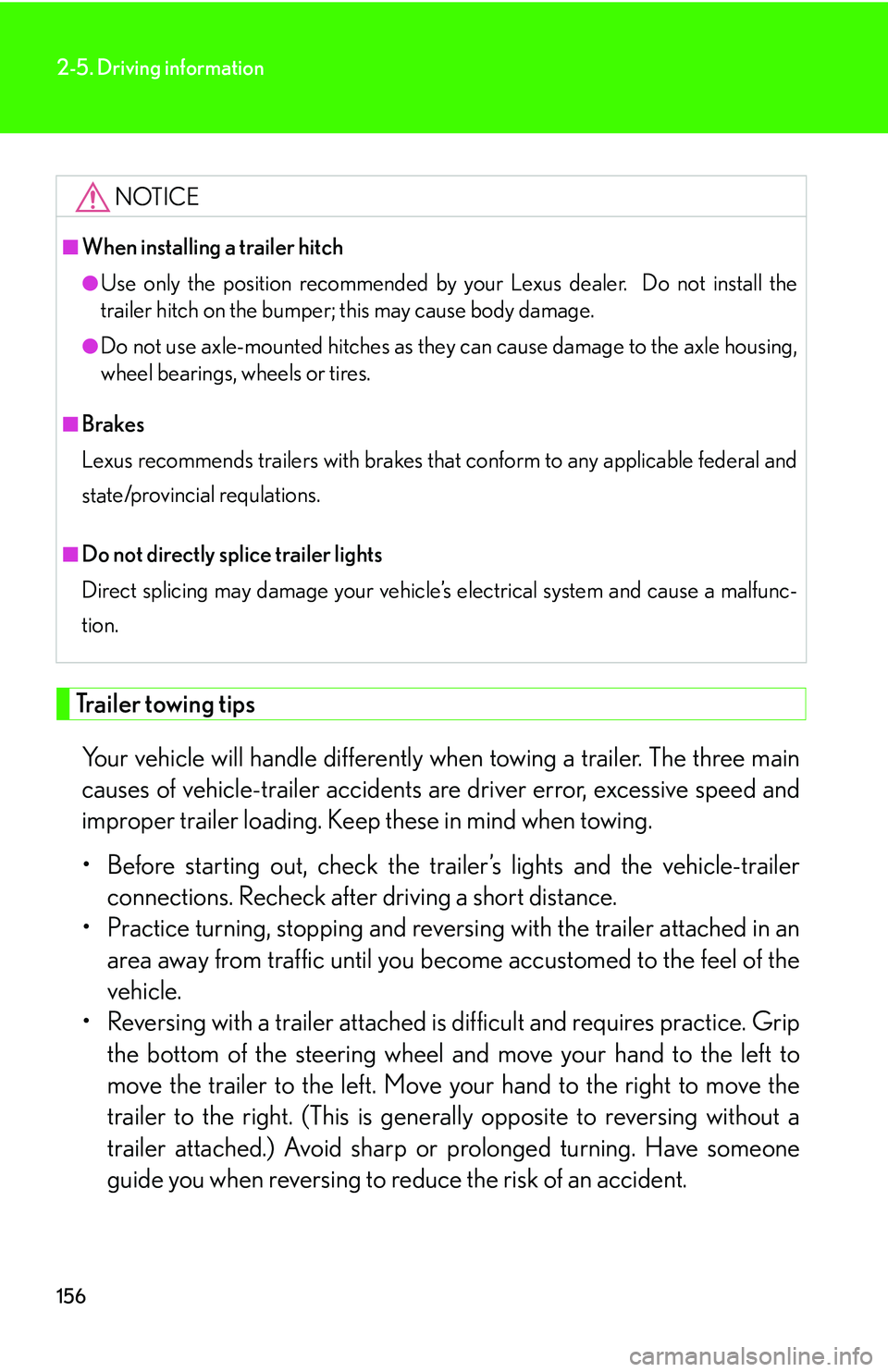
156
2-5. Driving information
Trailer towing tips
Your vehicle will handle differently when towing a trailer. The three main
causes of vehicle-trailer accidents are driver error, excessive speed and
improper trailer loading. Keep these in mind when towing.
• Before starting out, check the tra iler
’s lights and the vehicle-trailer
connections. Recheck after driving a short distance.
• Practice turning, stopping and reversi ng with the tr
ailer attached in an
area away from traffic until you be come accustomed to the feel of the
vehicle.
• Reversing with a trailer attached is dif
ficult and requires practice. Grip
the bottom of the steering wheel and move your hand to the left to
move the trailer to the left. Move yo ur hand to the right to move the
trailer to the right. (This is gene rally opposite to reversing without a
trailer attached.) Avoid sharp or prolonged turning. Have someone
guide you when reversing to redu ce the risk of an accident.
NOTICE
■When installing a trailer hitch
●Use only the position recommended by your Lexus dealer. Do not install the
trailer hitch on the bumper; this may cause body damage.
●Do not use axle-mounted hitches as they can cause damage to the axle housing,
wheel bearings, wheels or tires.
■Brakes
Lexus recommends trailers with brakes that conform to any applicable federal and
sta
te/provincial requlations.
■Do not directly splice trailer lights
Direct splicing may damage your vehicle’s electrical system and cause a malfunc -
tion.